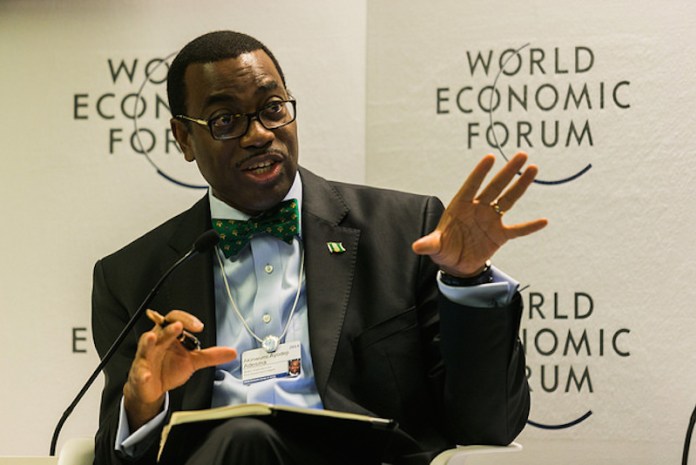- African Economy on Growth Path, Says Adesina
African Development Bank (AfDB) has described economies of the African countries as resilient and on the growth path, despite the global economic headwinds, climate and regional shocks in 2017.
President of the bank, Dr. Akinwunmi Adesina, observed that real Gross Domestic Product (GDP) growth was estimated at 3.6 per cent in 2017, up from 2.2 per cent in 2016, adding that 18 African countries grew above five per cent in 2017, and 37 countries above three per cent.
Adesina, at the 2018 Diplomatic Luncheon, held at Abidjan, Cote D’Ivoire, said the prospects for growth in the year ahead are actually much brighter.
According to him, “Our own recently released African Economic Outlook projects Africa’s GDP growth to accelerate to 4.1 per cent in 2018 and 2019. The recovery has been faster than some had envisaged, especially among the non-resource-rich economies, essentially underscoring Africa’s economic resilience.
“Our heads are above water and Africa’s economies are moving forward strongly and confidently. At the same time, we will continue to support African countries in ensuring stronger macroeconomic policies as we go forward.”
On the bank’s progress, Adesina said the financial strength continues to be reinforced, maintaining its AAA rating, with stable outlook, by all four global rating agencies.
The Bank’s AAA stable outlook rating is underpinned by sound financial and risk management policies, excellent liquidity and strong shareholder support, he said.
The bank achieved its highest annual disbursement ever in its history, at $7.67 billion.
“Our investment in the energy sector in 2017 covered 31 operations in 23 countries, and totaled $1.39 billion, representing a 30 per cent increase over 2016.
“The Bank launched its largest bond transaction, with a $2.5 billion three-year global benchmark, followed by its largest ever 5-year global benchmark for $2 billion. The Bank continues to grow its income solidly, reversing the declining income of the Bank when I started two years ago,” Adesina said.
The net operating income of the Bank had declined from $589.3 million in 2014 to $492.7 million in 2015, when Adesina took over. Ever since, there has seen a rapid turnaround.
“In 2016, the net operating income rose to $556.6 million, and shot up to $855 million in 2017, an increase of almost 54 per cent over 2016. And to put things in context, this is also a 73 per cent increase over where we were in 2015.
“The Bank is mobilising more resources for Africa. In 2017, we mobilised $9.73 billion from the capital markets for African countries, including $300 million from the Enhanced Private Sector Facility for Africa.
“I am delighted that last year, the Bank helped leverage $6 billion for the landmark Japan-Africa Energy Financing Facility. This will help accelerate efforts to light up and power Africa, and I am most grateful to Prime Minister Shinzo Abe for helping to make this happen.
“We are doing a lot on our Light Up and Power Africa agenda. Last year we invested $ 1.39 billion in improving access to electricity, to help generate an additional 1,400 MW of power and connect 3.8 million persons to electricity. “
“More importantly, the African Development Bank is leading on renewable energy. When I started as President two years ago, the share of renewable energy in our total power portfolio was just 14 per cemt. However, we increased that to 74 per cent in 2016. And in 2017, we achieved a record-breaking 100 per cent of our new lending in renewable energy. With access to more funding, we hope to provide electricity to an unprecedented 29.3 million Africans between 2018-2020.”
He added that with adequate resources between 2018-2020, the Bank expects to provide $29.2 million Africans with access to electricity; our Feed Africa work will allow $45.8 million persons to benefit from improved access to agricultural technologies; and the Integrate Africa High 5 will provide 50 million Africans with improved access to transportm
“Our High 5 on Industrializing Africa will enable 7 million people to benefit from investee projects and our High 5 on improving the quality of life will provide 36.8 million persons with improved access to water and sanitation.
“The Bank continues to deliver impressive results. Since GCI-6, the Bank has delivered a 17-fold increase in lending to ADF countries. That’s why investing by our shareholders in the Bank will help to further accelerate Africa’s development.
“I am pleased to let you know that several multilateral development banks have already joined with the Bank on this landmark platform, Africa’s largest, to accelerate private investments.
“So, the African Development Bank, your Bank, is reforming, innovating, leading and delivering more for Africa, than ever before. With the strong support for a General Capital Increase by our Board of Directors, Governors of the Bank, and you the Ambassadors representing our shareholder countries, Africa will indeed experience a much brighter and impactful future.”



 Naira4 weeks ago
Naira4 weeks ago


 Naira3 weeks ago
Naira3 weeks ago


 News4 weeks ago
News4 weeks ago
 Travel4 weeks ago
Travel4 weeks ago




 Naira4 weeks ago
Naira4 weeks ago


 Jobs3 weeks ago
Jobs3 weeks ago
 Naira3 weeks ago
Naira3 weeks ago


 Travel3 weeks ago
Travel3 weeks ago




















